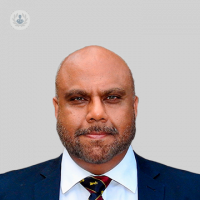What causes an abdominal wall hernia?
Written in association with:An abdominal wall hernia is normally categorised as a bulge of either one’s fat or bowel that bulges through the muscles of one’s abdominal wall. In our latest article, Mr Parv Sains, a highly esteemed general surgeon, explains what causes abdominal wall hernias, outlines the main symptoms, and reveals what the most effective form of treatment to treat them is.

What is an abdominal wall hernia?
Abdominal wall or ventral hernias are bulges of tissue (fat or bowel) that occur through a hole in the muscles of the abdominal wall. There are three types of midline hernia:
1. Epigastric (occurs anywhere between the breastbone and belly button).
2. Umbilical (at or around the belly button).
3. Incisional (through the site of a previous incision and scar from an operation).
What causes an abdominal wall hernia?
The most common cause of an abdominal wall hernia is increased strain on the abdominal wall muscles, which leads to weakness. Causes of strain on the abdominal wall include chronic cough, obesity, pregnancy, occupations, and exercise that incur frequent lifting and straining. Constant straining when passing stool or passing urine and weakness associated with general ageing of the muscle tissues are also common causes.
What are the symptoms of an abdominal hernia?
The symptoms are normally associated with a bulge on the front of the stomach, and can be associated with pain, discomfort, and/or a dragging sensation. The hernia bulge may be subtle or quite visible, even through clothing. An ultrasound scan, CT scan, or MRI scan may be used to diagnose the hernia.
How do you treat an abdominal wall hernia?
Inguinal hernias can be treated by a ‘watch and wait’ policy where no operation takes place. However, there are risks of enlargement of the hernia, which may then lead to more symptoms of pain and discomfort which might possibly reduce mobility and interfere with daily activities and work. More seriously, the hernia and its contents can become stuck (incarceration or strangulation) which would require emergency surgery.
The other option is a surgical repair, and this can be done with an open or keyhole (laparoscopic) technique. The repair is usually done under general anaesthetic and a suture (stitch) repair is used. Sometimes, a mesh is used for larger holes in the abdominal wall muscle. The method of repair depends on a number of different factors, including the size of the hernia, any pre-existing illnesses of the patient, as well as age.
How serious is an abdominal wall hernia?
Abdominal wall hernias can be inconsequential. Some are completely asymptomatic and people do not notice they have them. However, on the other hand, some can be quite significant as they can become large, uncomfortable, and cosmetically very visible. The most serious consequence is if the hernia gets stuck and then requires emergency surgery.
Mr Parv Sains is an incredibly experienced, trusted, and skilled general surgeon who can help you get your abdominal wall hernia treated in a safe and timely manner. Book a consultation with him today via his Top Doctors profile.


